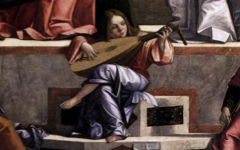Carpaccio’s Young Knight in a Landscape (1510)
Carpaccio's large 1510 painting of a knight has fueled a long, unsuccessful search for the identity of the principal figure (assuming that this is a portrait) and there have been many attempts to match the picture's natural details with well-known symbols. Neither approach has been successful. What we do know, though, is that this is a strange scene.

Carpaccio, Young Knight in a Landscape (1510) Museo Thyssen-Bornemisza, Madrid
Click image to enlarge.
Rona Goffen wrote that the rider is "so far removed from the knight, physically as well as psychologically, that they seem literally to exist in different worlds.....the disjunction of scale between the Squire and his Knight, too great a difference to represent naturalistic diminuition in this space, may signify that the Knight and his Squire exist in different realms.’1 She assumed, therefore, that this is a posthumous portrait. Even if true, the two figures are in different ‘worlds’ because the knight is the ‘artist’, his sword a ‘brush’, the background his ‘painting’. The artist-knight, like Manet’s Mlle V as a Matador, is painting his own ‘picture.’ That is why their scale is so different.
Click next thumbnail to continue

After Giorgione, Self-portrait as David with the Head of Goliath (engraving by W. Hollar)
Click image to enlarge.
Perry Chapman, a Rembrandt specialist, has noted that ‘armor and battle are frequently associated with the artist and the Art of Painting.’2 Indeed the use of military metaphor to convey art's creation cannot be overstated though it is still little known to most art historians. Many artists, including Carpaccio's Venetian contemporary Giorgione (at left), portrayed themselves wearing armor though they were not soldiers. Armour, brightly polished, has long been used to convey the mind's reflection of reality so look closely at armor and what is in it.
Click next thumbnail to continue
Here, in a surprise, the armour seems to reflect an indoor scene both in the window-like forms in the breast-plate and the warm, reddish reflections on the legs. We are both inside and outside, a situation with a long but little-known tradition in art. The artist-as-knight imagines himself standing with a giant brush (his sword) in an indoor studio fused with the scene he is painting.
Click next thumbnail to continue

Carpaccio, Young Knight in a Landscape (1510) Museo Thyssen-Bornemisza, Madrid
Click image to enlarge.
Even if the knight resembles the patron (which I doubt) he represents the artist ready to do battle with his art. Major examples worth comparing this composition to include Caravaggio's David with the Head of Goliath, Coello's St. Louis Worshipping the Holy Family, Goya's 2nd May, 1808 and Gainsborough's Mr and Mrs Robert Andrews. An artist with his art is such a common theme on the poetic level of art that if you sense two realities in a painting, as Goffen did here, that might well be what you are looking at. Keep it in mind.
More Works by Carpaccio
Notes:
1. Rona Goffen, “Carpaccio’s Portrait of a Young Knight: Identity and Meaning”, Arte Veneta XXXVII, 1983, pp.37, 44-45
2. Perry H. Chapman, The Image of the Artist: Roles and Guises in Rembrandt’s Self-Portraits, PhD diss. (Princeton University), 1983, p.115
Original Publication Date on EPPH: 07 Oct 2011. | Updated: 0. © Simon Abrahams. Articles on this site are the copyright of Simon Abrahams. To use copyrighted material in print or other media for purposes beyond 'fair use', you must obtain permission from the copyright owner. Websites may link to this page without permission (please do) but may not reproduce the material on their own site without crediting Simon Abrahams and EPPH.



